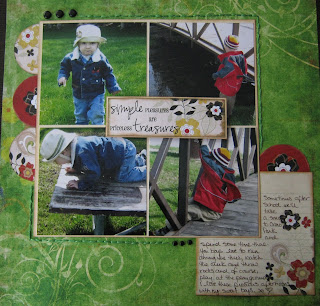We all know a picture is worth a thousand words. That is until you forget where you were, when it was or even who is in the picture. For the scrapbooker, forgetting the details of your photos poses an acute problem and I've witnessed scrappers spending hours trying to sort and organize photos they can no longer remember the story behind.
At the same time, many scrapbookers don't see the value in journaling on their pages. Some say they're intimidated by journaling, others that they just don't have anything to say. But I say, once you think about the reason you're scrapping those photos in the first place what you should journal is obvious: it's the thing you find special.
Whether it's a single sentence, a few lines or an entire typewritten page, the stories behind your photos will convey the meaning of those photos to those lucky viewers of your albums.
Asking yourself "W5H" is a great way to get journaling started:
* Who is in the photos? Who took the photo? Who is missing from the photo?
* What are the photos of? (An occasion? A tradition? An activity?) What does the photo show or hide?
* Where were the photos taken? What is the significance of the place or objects in the photo?
* Why these photos? (i.e Why the one close up of the bouquet instead of a the bride holding it?) Why not other photos?
* When were the photos taken? When was the journaling done? When in your life, or the subject's life was the photo taken?
* How does the photo make you feel? How well does the photo capture the moment? How often do you think of or look at the photo or the subject?
If you answer one or two of these questions, or similar ones, you're well on your way to telling the stories behind your photos.
Whatever you decide to include in your journaling, there are a few things every page should have: a date and identification. Even if it's something as vague as "Spring 2011", dating your pages will put your page in a timeline context, and for the chronological scrapbooker, will make ordering your pages easier. Identifying your subjects may seem repetitive and unnecessary (after all you're not going to forget who your children or your parents are) but I've seen lots of people forget which baby it was in a particular photo or the names of their grandparents. If you have that information, even if it seems irrelevant, include it for the people who may not know your subjects as well as you do.
And if you're still not sure whether journaling is for you, remember this:
"And by the way, everything in life is writable about if you have the outgoing guts to do it, and the imagination to improvise. The worst enemy to creativity is self-doubt."
~Sylvia Plath
Friday, 15 April 2011
Friday, 1 April 2011
Tried and True
Clearly, I'm a fan of sketches. But even using those can be a burdensome drain on my sensibilities when I'm scrapping late at night or in a rush to get pages done. Looking over my albums, I find there's one tried and true layout I come back to again and again when I want a simple photo-focused page: the gap grid.
Quite simply, this layout is a grid of multiple photos, in the same or various sizes, with a 1/4" gap between the pictures. I usually use an over sized mat to accommodate all the photos and sometimes the title.
I discovered this layout early on and have used it repeatedly because of the sleek, uncluttered look as well as the fairly short time it takes to assemble the page. It works for single and double page layouts and is a great way to keep the photos the centre of attention.
If you're looking to try something new or are looking to put together a big-impact page in a short amount of time, try the gap grid!
Quite simply, this layout is a grid of multiple photos, in the same or various sizes, with a 1/4" gap between the pictures. I usually use an over sized mat to accommodate all the photos and sometimes the title.
I discovered this layout early on and have used it repeatedly because of the sleek, uncluttered look as well as the fairly short time it takes to assemble the page. It works for single and double page layouts and is a great way to keep the photos the centre of attention.
 |
| My first page using a gap grid. The gaps and colour scheme make the photos pop off the page. |
 |
| Inspired by a layout I saw in SBE, this small gap grid keeps the photos the focal point against the busy background. |
 |
| Photos are the star of this simple, quickly assembled page. The mismatched title tiles match the playful theme of the page and journaling along the perimeter of the grid completes the story. |
Subscribe to:
Posts (Atom)
